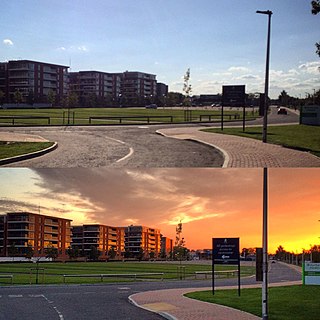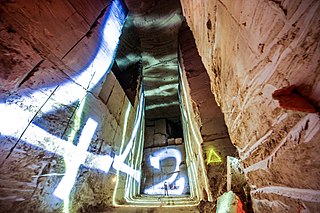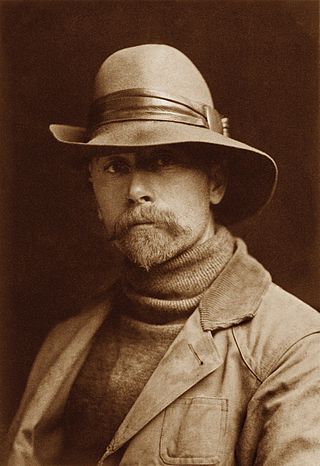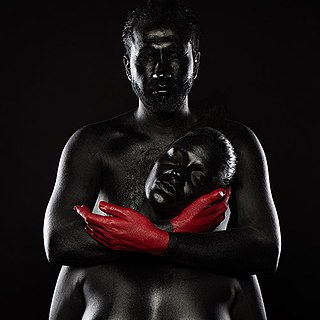
A flash is a device used in photography that produces a brief burst of light at a color temperature of about 5500 K to help illuminate a scene. A major purpose of a flash is to illuminate a dark scene. Other uses are capturing quickly moving objects or changing the quality of light. Flash refers either to the flash of light itself or to the electronic flash unit discharging the light. Most current flash units are electronic, having evolved from single-use flashbulbs and flammable powders. Modern cameras often activate flash units automatically.

Underwater photography is the process of taking photographs while under water. It is usually done while scuba diving, but can be done while diving on surface supply, snorkeling, swimming, from a submersible or remotely operated underwater vehicle, or from automated cameras lowered from the surface.

Macro photography is extreme close-up photography, usually of very small subjects and living organisms like insects, in which the size of the subject in the photograph is greater than life size . By the original definition, a macro photograph is one in which the size of the subject on the negative or image sensor is life size or greater. In some senses, however, it refers to a finished photograph of a subject that is greater than life size.

Three-point lighting is a standard method used in visual media such as theatre, video, film, still photography, computer-generated imagery and 3D computer graphics. By using three separate positions, the photographer can illuminate the shot's subject however desired, while also controlling the shading and shadows produced by direct lighting.

Fill flash is a photographic technique used to brighten deep shadow areas, typically outdoors on sunny days, though the technique is useful any time the background is significantly brighter than the subject of the photograph, particularly in backlit subjects. To use fill flash, the aperture and shutter speed are adjusted to correctly expose the background, and the flash is fired to lighten the foreground.

In photography, the golden hour is the period of daytime shortly after sunrise or before sunset, during which daylight is redder and softer than when the sun is higher in the sky.

The key light is the first and usually most important light that a photographer, cinematographer, lighting cameraman, or other scene composer will use in a lighting setup. The purpose of the key light is to highlight the form and dimension of the subject. The key light is not a rigid requirement; omitting the key light can result in a silhouette effect. Many key lights may be placed in a scene to illuminate a moving subject at opportune moments.

In television, film, stage, or photographic lighting, a fill light may be used to reduce the contrast of a scene to match the dynamic range of the recording media and record the same amount of detail typically seen by eye in average lighting and considered normal. From that baseline of normality, using more or less fill will make shadows seem lighter or darker than normal, which will cause the viewer to react differently, by inferring both environmental and mood clues from the tone of the shadows.

A photographic studio is often a business owned and represented by one or more photographers, possibly accompanied by assistants and pupils, who create and sell their own and sometimes others’ photographs.

Rembrandt lighting is a standard lighting technique that is used in studio portrait photography and cinematography; it is also used in contrast with butterfly lighting It can be achieved using one light and a reflector, or two lights, and is popular because it is capable of producing images which appear both natural and compelling with a minimum of equipment. Rembrandt lighting is characterized by an illuminated triangle under the eye of the subject on the less illuminated side of the face. It is named for the Dutch painter Rembrandt, who occasionally used this type of lighting.

Hard and soft light are different types of lighting that are commonly used in photography and filmmaking. Soft light is light that tends to "wrap" around objects, projecting diffused shadows with soft edges, whereas hard light is more focused and produces harsher shadows.

In lighting design, backlighting is the process of illuminating the subject from the back. In other words, the lighting instrument and the viewer face each other, with the subject in between. This creates a glowing effect on the edges of the subject, while other areas are darker. The backlight can be a natural or artificial source of light. When artificial, the back light is usually placed directly behind the subject in a 4-point lighting setup. A back light, which lights foreground elements from the rear, is not to be confused with a background light, which lights background elements.

Light painting, painting with light,light drawing, or light art performance photography are terms that describe photographic techniques of moving a light source while taking a long-exposure photograph, either to illuminate a subject or space, or to shine light at the camera to 'draw', or by moving the camera itself during exposure of light sources. Practiced since the 1880s, the technique is used for both scientific and artistic purposes, as well as in commercial photography.

Portrait photography, or portraiture, is a type of photography aimed toward capturing the personality of a person or group of people by using effective lighting, backdrops, and poses. A portrait photograph may be artistic or clinical. Frequently, portraits are commissioned for special occasions, such as weddings, school events, or commercial purposes. Portraits can serve many purposes, ranging from usage on a personal web site to display in the lobby of a business.

Forensic photography may refer to the visual documentation of different aspects that can be found at a crime scene. It may include the documentation of the crime scene, or physical evidence that is either found at a crime scene or already processed in a laboratory. Forensic photography differs from other variations of photography because crime scene photographers usually have a very specific purpose for capturing each image. As a result, the quality of forensic documentation may determine the result of an investigation, in that with the absence of good documentation, investigators may find it impossible to conclude what did or did not happen.

In photography and cinematography, available light refers to any available source of light that is not explicitly supplied by the photographer for the purpose of taking pictures. The term usually refers to light sources in the surrounding environment that are present naturally or artificial lighting that are already pre-existing. It generally excludes flashes, although arguably flash lighting provided by other photographers shooting simultaneously in the same space could be considered available light. Light sources that affect the scene and are included in the actual frame are called practical light sources, or simply practicals.
Architectural photography is the sub genre of the photography discipline where the primary emphasis is made to capturing photographs of buildings and similar architectural structures that are both aesthetically pleasing and accurate in terms of representations of their subjects. Architectural photographers are usually skilled in the use of specialized techniques and cameras for producing such specialized photography.

In photography and cinematography, a reflector is an improvised or specialised reflective surface used to redirect light towards a given subject or scene.

A beauty dish is a photographic lighting device that uses a parabolic reflector to distribute light towards a focal point. The light created is between that of a direct flash and a softbox, giving the image a wrapped, contrasted look, which adds a more dramatic effect.

Low-key photography is a genre of photography consisting of shooting dark-colored scenes by lowering or dimming the "key" or front light illuminating the scene, and emphasizing natural or artificial light only on specific areas in the frame. This photographic style is usually used to create a mysterious atmosphere, that only suggests various shapes, often graphic, letting the viewer experience the photograph through subjective interpretation and often implies painting objects or the human body with black non-toxic dyes or pigments.

















